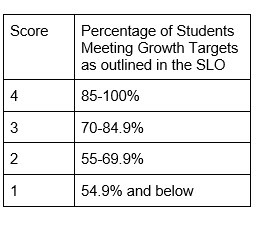Armada Area Schools Evaluation Program
We are committed to developing an evaluation process that supports the continual improvement of our instructional practices and collaboration with all stakeholders.
Danielson Observation Tool
Armada Area Schools utilizes the Danielson Observation Tool. The Danielson Observation Tool looks at four domains. Each domain is scored 1-4. The domain score is then multiplied by .20 for a total score. An example can be found below:
Domain | Rating | Multiplied By | Total Score |
1 | 3 | .20 | .60 |
Every teacher will be formally observed at least 1 time per school year using the Danielson rubric. The first formal observation will take place prior to Christmas break. Non-tenured teachers will have an additional formal observation prior to April 15th. If receiving two formal observations, ratings from each observation will be taken into consideration when completing the final evaluation form. Informal observations are non-scheduled and can take place at any time.
All teachers will hold a pre-observation meeting with their respective administrator prior to a formal observation. At the pre-observation meeting, the anticipated lesson, goals for the school year, questions and concerns, etc. can be discussed. In addition, student learning objective goals should be discussed. For all formal observations, teachers should also plan to submit a copy of their lesson plan to their observing administrator at least 2 days prior to the evaluation. A post-observation meeting with the respective administrator will be held with all teachers within 10 days of the observation and teachers will be provided written feedback.
Data
Evaluation scores also include data scores that come from teacher-created, administrator-approved “Student Learning Objectives (SLOs).” Data comprises the remaining 20% of the evaluation.
Student Learning Objectives (SLOs)
Data is based on teacher-created and administrator-approved “Student Learning Objectives (SLOs).” Each teacher must have a minimum of two SLO goals, although only one will be used in the final evaluation. All teachers are required to fill out the SLO template found here for each SLO goal. More information, including a template to create SLOs, can be found here.
Please note SLOs pertain to the current school year. Within the template, teachers must define the scores. For reference, previous SLOs were rated based on the chart below:

Final Evaluation
The scores received from the Danielson Observation Tool, in combination with the teacher’s data score, is what is used to determine a final, overall evaluation score. An example of a final evaluation cover sheet that outlines all components of the evaluation can be found here.







